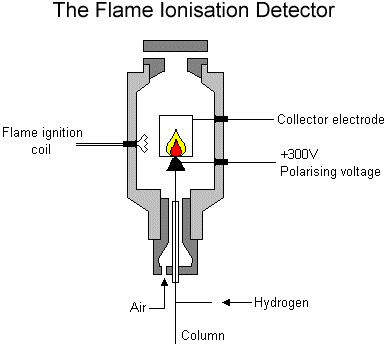GC Detectors
Detectors
There
are many detectors which can be used in gas chromatography. Different
detectors will give different types of selectivity. A non-selective detector responds to all compounds except the carrier gas, a selective detector responds to a range of compounds with a common physical or chemical property and a specific detector responds to a single chemical compound. Detectors can also be grouped into concentration dependant detectors and mass flow dependant detectors.
The signal from a concentration dependant detector is related to the
concentration of solute in the detector, and does not usually destroy
the sample Dilution of with make-up gas will lower the detectors
response. Mass flow dependant detectors usually destroy the sample, and
the signal is related to the rate at which solute molecules enter the
detector. The response of a mass flow dependant detector is unaffected
by make-up gas. Have a look at this tabular summary of common GC
detectors:
| Detector | Type | Support gases | Selectivity | Detectability | Dynamic range |
|---|---|---|---|---|---|
| Flame ionization (FID) | Mass flow | Hydrogen and air | Most organic cpds. | 100 pg | 107 |
| Thermal conductivity (TCD) | Concentration | Reference | Universal | 1 ng | 107 |
| Electron capture (ECD) | Concentration | Make-up | Halides, nitrates, nitriles, peroxides, anhydrides, organometallics | 50 fg | 105 |
| Nitrogen-phosphorus | Mass flow | Hydrogen and air | Nitrogen, phosphorus | 10 pg | 106 |
| Flame photometric (FPD) | Mass flow | Hydrogen and air possibly oxygen | Sulphur, phosphorus, tin, boron, arsenic, germanium, selenium, chromium | 100 pg | 103 |
| Photo-ionization (PID) | Concentration | Make-up | Aliphatics, aromatics, ketones, esters, aldehydes, amines, heterocyclics, organosulphurs, some organometallics | 2 pg | 107 |
| Hall electrolytic conductivity | Mass flow | Hydrogen, oxygen | Halide, nitrogen, nitrosamine, sulphur |

The
effluent from the column is mixed with hydrogen and air, and ignited.
Organic compounds burning in the flame produce ions and electrons which
can conduct electricity through the flame. A large electrical
potential is applied at the burner tip, and a collector electrode is
located above the flame. The current resulting from the pyrolysis of
any organic compounds is measured. FIDs are mass sensitive rather than
concentration sensitive; this gives the advantage that changes in
mobile phase flow rate do not affect the detector's response. The FID
is a useful general detector for the analysis of organic compounds; it
has high sensitivity, a large linear response range, and low noise. It
is also robust and easy to use, but unfortunately, it destroys the
sample.
http://teaching.shu.ac.uk/hwb/chemistry/tutorials/chrom/gaschrm.htm
No comments:
Post a Comment